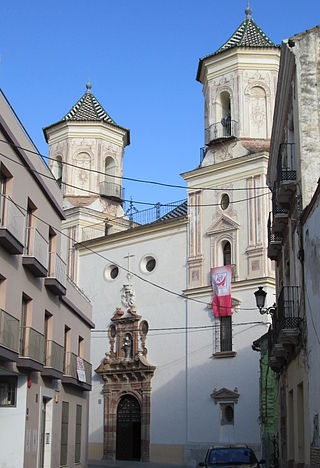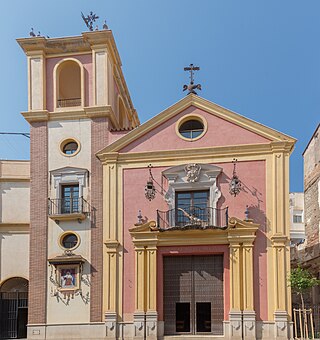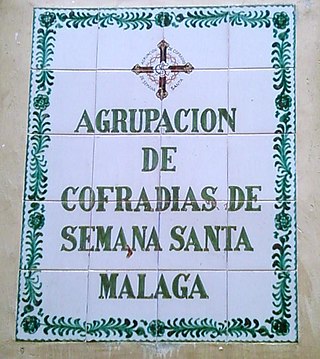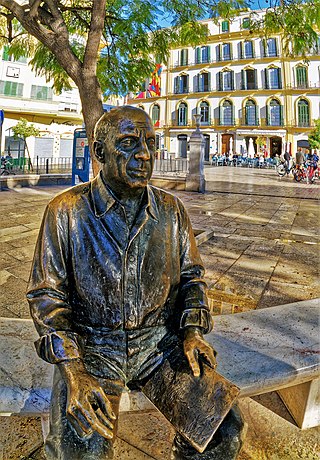Self-guided Sightseeing Tour #4 in Málaga, Spain
Legend
Guided Free Walking Tours
Book free guided walking tours in Málaga.
Guided Sightseeing Tours
Book guided sightseeing tours and activities in Málaga.
Tour Facts
6.9 km
118 m
Experience Málaga in Spain in a whole new way with our free self-guided sightseeing tour. This site not only offers you practical information and insider tips, but also a rich variety of activities and sights you shouldn't miss. Whether you love art and culture, want to explore historical sites or simply want to experience the vibrant atmosphere of a lively city - you'll find everything you need for your personal adventure here.
Activities in MálagaIndividual Sights in MálagaSight 1: Museo del Vino

The Malaga Wine Museum is a wine museum in the Spanish city of Malaga.
Sight 2: Sala Unicaja de Conciertos María Cristiana
The Sala María Cristina is a music auditorium located in the city of Malaga, Spain and managed by the Unicaja Foundation. It is located in part of what was formerly the Franciscan convent of San Luis el Real. The hall has a capacity of 364 spectators. The room is located between Calle Marqués de Valdecañas and Plaza de San Francisco in the La Goleta neighbourhood in the Centro District and has a total area of more than 2322 m².
Sight 3: Iglesia de San Felipe Neri
The church of San Felipe Neri, also known as the church of the Holy Cross and San Felipe Neri, is located in the neighborhood of San Felipe Neri, in the Centro district of Malaga (Spain).
Sight 4: Museo del Vidrio y Cristal
The Museum of Glass and Crystal is a museum of decorative arts in the city of Malaga, Spain. It is located at number 2 of the Plazuela del Santísimo Cristo de la Sangre, in the neighborhood of San Felipe Neri, in front of the church that gives the neighborhood its name. The visits are always guided.
Sight 5: Mercado Salamanca
The Salmanca Market is a municipal market in the Andalusian city of Malaga, Spain. It is located in the neighborhood of El Molinillo, in the Centro district.
Wikipedia: Mercado de Salamanca (Málaga) (ES), Heritage Iaph Website
Sight 6: Iglesia de Nuestra Señora de Fátima
The Church of Our Lady of Fatima is a Roman Catholic church in the city of Malaga, Andalusia, Spain.
Wikipedia: Iglesia de Nuestra Señora de Fátima (Málaga) (ES)
Sight 7: Ermita de Zamarrilla
The hermitage of Zamarrilla, sometimes called simply Ermita Zamarrilla, is a small Catholic Christian temple located on the border of the neighborhoods of El Perchel and La Trinidad, in the city of Malaga. The Brotherhood of Zamarrilla is based there. It is an eighteenth-century work by the architects Felipe Pérez Conde and Felipe Pérez "the younger".
Sight 8: Fuente de las Tres Gitanillas
The Fountain of the Three Gypsies is a regionalist-style monument that occupies the central place of the Plaza del Poeta Manuel Alcántara in the Spanish city of Malaga. It was designed in 1959 and its construction was completed in 1960.
Sight 9: Iglesia de Santo Domingo
The church of Santo Domingo de Guzmán in Malaga, popularly known as the convent of Santo Domingo, is a temple dating from the fifteenth century, built after the Christian conquest and originally located outside the walls of the medieval city. It is only a part of the convent complex that occupied the block located in the northern area of the El Perchel neighborhood, on the right bank of the Guadalmedina River.
Sight 10: Mercado de Atarazanas
The Central Market of Atarazanas is a municipal market in the Spanish city of Malaga, in the autonomous community of Andalusia.
Sight 11: Museo de Artes y Costumbres Populares
The Museum of Popular Arts and Customs, also called the Unicaja Museum of Popular Arts, is an ethnographic museum located in the Historic Center of Malaga, Spain.
Wikipedia: Museo de Artes y Costumbres Populares (Málaga) (ES)
Sight 12: Mesón de San Rafael
The old inn of San Rafael is a property in the city of Malaga (Spain), located on Calle Compañía. The complex is located in the vicinity of the old access gates to Malaga, in an area that was historically dedicated to the hotel industry, probably with its origin in the Muslim funduq, having maintained both the activity and the urban fabric until the Modern and Contemporary Age, contributing to configure, to a large extent, the landscape of this part of the city. It is very characteristic as a neoclassical style inn-type, whose forms refer to a classicist language, with small ornamental concessions, the building occupying the interior of the block.
Sight 13: Iglesia del Sagrado Corazón
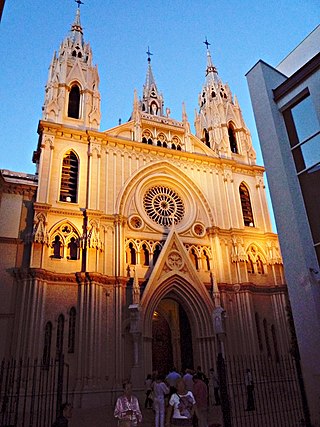
The Church of the Sacred Heart is located in the Plaza de San Ignacio de Loyola in the historic center of Malaga, Spain.
Sight 14: Museo Carmen Thyssen Málaga
The Carmen Thyssen Museum is an art museum in the Spanish city Málaga. The main focus of the museum is 19th-century Spanish painting, predominantly Andalusian, based on the collection of Carmen Cervera, fifth wife of Baron Hans Heinrich Thyssen-Bornemisza.
Sight 15: Iglesia de Santa María Reina y Madre
The oratory of Santa María Reina y Madre is a Catholic Christian temple, located in the historic center of the city of Malaga, Spain. The temple was built in 2008 and was consecrated on November 1, 2008 as the headquarters of the Brotherhood of the Sorrows.
Sight 16: Museo de la Semana Santa
The Museum of Holy Week in Malaga is located in the historic centre of the city, in the building of the old Hospital de San Julián. It is a religious museum, inaugurated in 2010. It is managed by the Association of Brotherhoods and exhibits a collection of pieces from the history of the brotherhoods and the Association, the processions, music, crafts, imagery, oil paintings, thrones and belongings related to Holy Week in Malaga.
Sight 17: Museo Interactivo de la Música
The Interactive Museum of Music Malaga (MIMMA) was created in 2003 and consists of more than 1000 instruments from different periods, countries and cultures; which makes it one of the most complete private collections in Spain, due to its variety as well as its size.
Wikipedia: Museo Interactivo de la Música de Málaga (ES), Website
Sight 18: Teatro Cervantes
The Cervantes Theatre in the Spanish city of Malaga is one of the oldest stage spaces in the capital of the Costa del Sol. It dates from 1870 and has one thousand two hundred localities. It is the main venue of the Malaga Film Festival
Sight 19: Fundación Picasso Museo Casa Natal
The Fundación Picasso, also known as the Pablo Ruiz Picasso Foundation, is a foundation based in Málaga, Andalusia, Spain with the objective of promoting and promulgating the work of the artist Pablo Picasso. They are headquartered in the home on the Plaza de la Merced that was his birthplace, now the Museo Casa Natal, one of the world's many Picasso museums.
Sight 20: Monumento a Pablo Picasso
The Statue of Pablo Ruiz Picasso is a sculpture by Francisco López Hernández that is located in his hometown of Malaga, Spain. It depicts the artist sitting on a marble bench, with a notebook and pencil. It was inaugurated on December 5, 2008.
Sight 21: Monumento a Torrijos
The monument to Torrijos is an obelisk erected in honor of José María de Torrijos and Uriarte in the Plaza de la Merced in the city of Malaga, Spain. Designed by the municipal architect Rafael Mitjana and Ardison, is considered the most important and characteristic civil monument of Malaga of the XLX century.
Sight 22: Iglesia de Santiago
The Church of Santiago Apóstol is a Roman Catholic church located in the Andalusian city of Malaga (Spain). Its style is an exponent of two artistic moments of vital importance, the Gothic-Mudejar of the beginnings, with a clear symbiosis between the art of the Christian reconquerors and the Islamic population, and the emergence of the Baroque of the early eighteenth century, which produced in this building a strong building renovation corresponding to the new mentality. The artist Pablo Picasso was baptized in this church on November 10, 1881.
Sight 23: Alcazaba de Málaga
The Alcazaba is a palatial fortification in Málaga, Spain, built during the period of Muslim-ruled Al-Andalus. The current complex was begun in the 11th century and was modified or rebuilt multiple times up to the 14th century. It is one of the best-preserved alcazabas in Spain. The Alcazaba is also connected by a walled corridor to the higher Castle of Gibralfaro, and adjacent to the entrance of the Alcazaba are remnants of a Roman theatre dating to the 1st century AD.
Share
How likely are you to recommend us?
Disclaimer Please be aware of your surroundings and do not enter private property. We are not liable for any damages that occur during the tours.
GPX-Download For navigation apps and GPS devices you can download the tour as a GPX file.

